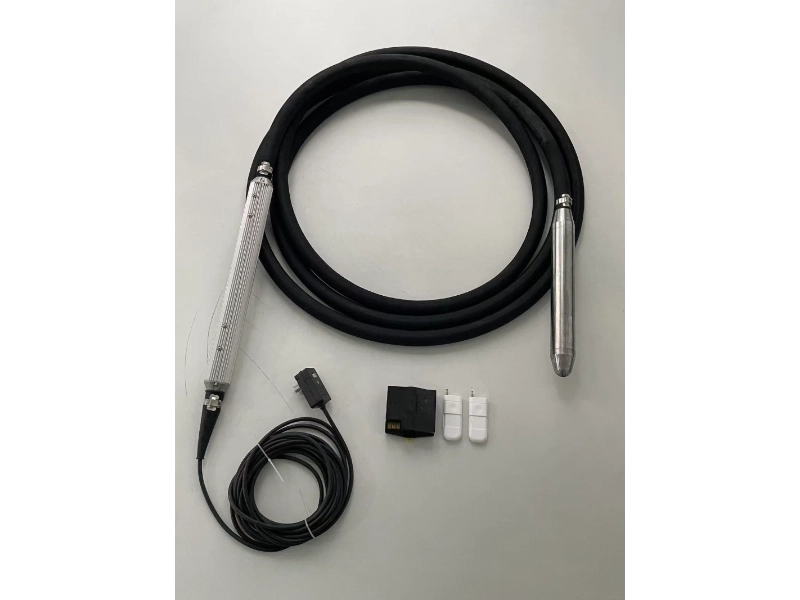Differences Between Permanent Magnet Synchronous Motors and Induction Motors in Concrete Vibrators
Release time: 2025-07-31
In modern construction, concrete vibrators are essential tools that effectively improve the density and uniformity of concrete, ensuring the quality of the structure. The power source of concrete vibrators is typically an electric motor, with common types being Permanent Magnet Synchronous Motors (PMSM) and Induction Motors (IM). These two types of motors differ in performance and application, and understanding their differences can help in selecting the appropriate motor type to improve work efficiency and reduce energy consumption.
1. Differences in Working Principles
The working principles of PMSMs and IMs are fundamentally different.
PMSMs:A permanent magnet synchronous motor uses permanent magnets as the rotor, and the magnetic field on the rotor rotates in sync with the rotating magnetic field generated by the stator, allowing precise speed control and higher operating efficiency.
IMs:In contrast, an induction motor does not have permanent magnets on the rotor; instead, the stator generates a magnetic field that induces an electric current in the rotor, creating a magnetic field that interacts with the stator’s field to cause the rotor to rotate. Due to the slip between the stator’s magnetic field and the rotor’s rotation, the efficiency of induction motors is generally lower.
2. Efficiency and Energy Consumption
PMSMs:Permanent magnet synchronous motors are more efficient under the same operating conditions because they do not suffer from current losses as induction motors do. This allows PMSMs to convert electrical energy into mechanical energy more efficiently. For concrete vibrators, this results in significant energy savings over extended periods of high-efficiency operation, which reduces electricity costs, particularly in large construction projects.
IMs:On the other hand, induction motors, due to the slip phenomenon, have lower energy conversion efficiency, meaning that for the same power output, they tend to consume more energy.
3. Control and Regulation
PMSMs:The speed control of PMSMs concrete vibrator is more precise because their speed is directly related to the frequency of the power supply. By changing the frequency, the motor speed can be controlled with high accuracy. This is crucial for concrete vibrators that require precise adjustment of vibration frequency and amplitude to optimize the concrete’s density.
IMs:Although induction motors can also be speed-controlled via a variable frequency drive (VFD), their speed is influenced by load variations, resulting in less precise control and slower response compared to PMSMs, which may not provide the same level of stability and accuracy.
4. Cost and Maintenance
PMSMs:From a cost perspective, induction motors are generally cheaper than permanent magnet synchronous motors. PMSMs require high-performance permanent magnetic materials, such as rare-earth elements, which increase production costs. However, despite the higher initial investment in PMSMs, their long-term energy efficiency and lower maintenance costs make them more cost-effective for high-load, high-frequency applications.
IMs:Induction motors are simpler to maintain, but due to their lower efficiency, they may incur higher energy costs and more frequent maintenance needs over time.
5. Service Life and Stability
PMSMs:PMSMs have a longer service life due to their simple structure and the absence of wear-prone components like slip rings and brushes. Their high stability and ability to run efficiently in high-load, high-frequency environments make them ideal for long-term use.
IMs:In comparison, although induction motor concrete vibrators have a durable and simple structure, their lower efficiency, higher heat losses, and slip may lead to reduced performance and more frequent wear on parts under high-load or high-temperature conditions, impacting their service life.
| Comparison Factor | Permanent Magnet Synchronous Motor (PMSM) | Induction Motor (IM) |
|---|---|---|
| Working Principle | Uses permanent magnets on the rotor, synchronized with the stator’s rotating magnetic field. | The stator generates a magnetic field that induces current in the rotor, causing rotation. |
| Efficiency and Energy Consumption | Higher efficiency due to no current losses, converting electrical energy into mechanical energy more effectively. | Lower efficiency due to slip phenomenon, consuming more energy for the same power output. |
| Speed Control and Regulation | Precise speed control, directly related to the frequency of the power supply. | Speed control through variable frequency drive (VFD), but less precise due to load variations. |
| Cost and Maintenance | Higher initial cost due to the use of rare-earth permanent magnets; lower long-term maintenance and energy costs. | Cheaper to produce but may incur higher long-term maintenance and energy costs due to lower efficiency. |
| Service Life and Stability | Longer service life with simple structure and no wear-prone components (e.g., slip rings). High stability and efficiency in high-load, high-frequency environments. | Shorter service life due to wear on components from lower efficiency and higher heat losses, reducing performance in high-load conditions. |
In conclusion, permanent magnet synchronous motors and induction motors each have their own advantages and disadvantages. When choosing a motor for a concrete vibrator, PMSMs are more suitable for applications requiring high frequency, high efficiency, and energy savings, as they offer precise control and lower energy consumption. Induction motors, on the other hand, are advantageous in terms of cost and maintenance and are better suited for applications with lighter loads and less demanding efficiency requirements. By selecting the appropriate motor type based on the specific needs of the construction site, work efficiency can be improved while long-term operating costs are reduced.


